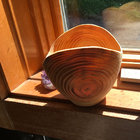Hello, all. I have dabbled in woodworking my whole life, a hope chest and a baby changing table during younger years, as well as lots of carving in basswood, like chains, balls in cages and small figures. I have had a Shopsmith for many years and have done minimal turning. In January, 2019, I purchased a Oneway 1640 through Alan Lacer after I saw a demo of his online, and visited his shop for a couple of days of one-on-one training. I don't have the talent of Heather or the skill yet to produce the work I see displayed on this site and others, but hope to spend a lot more time at it, once I retire in the not so distant future.
I am turning some small bowls for my staff for this holiday season. One is a natural edge bowl of holly, and half of the bark came off completely during the drying process. I like the look of the edge that is debarked. Is there a method for removing the bark that did not naturally come free without altering the edge below?
Thanks, Steve
I am turning some small bowls for my staff for this holiday season. One is a natural edge bowl of holly, and half of the bark came off completely during the drying process. I like the look of the edge that is debarked. Is there a method for removing the bark that did not naturally come free without altering the edge below?
Thanks, Steve

